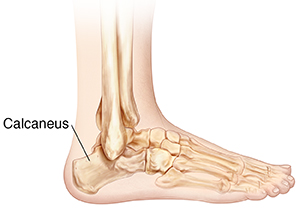Understanding Calcaneus Fracture Repair
Understanding Calcaneus Fracture Repair
The calcaneus is the heel bone. This bone may become fractured during a high-energy injury. This includes such things as a fall from a height or a car accident. The heel may break in several places. The fracture may cause your foot to become misshapen. It may be difficult or impossible to walk on. The injury is often very painful.
How to say it
kal-CAIN-ee-us
Why calcaneus fracture repair is done
A fracture of the heel bone may result in multiple pieces of broken bone. The broken pieces may be displaced. This means they no longer line up correctly with one another. You may need surgery to repair a heel fracture so you can use your foot again. During surgery, the doctor moves the pieces of bone back into place. The doctor than puts in metal devices (internal fixation) to hold the bone pieces in place while they heal.
How calcaneus fracture repair is done
The surgery is most often done on an outpatient basis. That means that you go home the same day. During the surgery:
You are given medicine to help you relax and to prevent pain. You will likely be given general anesthesia. This puts you into a state like deep sleep during the procedure. You may also have a nerve block. This numbs the foot below the ankle during the surgery and for a time afterward.
With open surgery: The doctor makes an incision over your heel. He or she moves the bones back into place. The doctor then places pins, wires, screws, or metal plates to hold the bone pieces together. He or she closes the skin incision with sutures. The fixation stays in place and is not generally removed.
With closed reduction (percutaneous fixation): The doctor moves the bone pieces back into place under the skin through small incisions. He or she inserts special screws to hold the bone pieces together. The fixation stays in place and is not generally removed.
Your foot is put into a splint or cast. You will likely be told not to put weight on the foot for several weeks after the surgery.
Depending on the severity of the fracture, you may still have problems with walking after the bone has healed. Orthotics or other support may help.
Risks of calcaneus fracture repair
Bleeding
Infection
Irritation to nearby nerves or tendons
Failure of the fracture to heal
Failure of the skin to heal
Pain and swelling that persists
Arthritis
A need for additional surgery in the future
Updated:
March 21, 2017
Sources:
Hatch RL, et al. Calcaneus fractures. Up To Date. January 21 ed: Up To Date; 2015. p. 61., Ishikawa SN. Calcaneal Fracture - Open Reduction and Internal Fixation, Percutaneous Fixation. In: Canale ST, editor. Campbell's Core Orthopaedic Procedures. Philadelphia: Elsevier; 2016. p. 424-30., Parvizi J, et al. Calcaneal Fractures. In: Parvizi J, editor. High-Yield Orthopaedics. Philadelphia: Saunders; 2010. p. 72-3.
Reviewed By:
Images Reviewed by Staywell medical art team.,Ogiela, Dennis M, MD,Ziegler, Olivia, MS, PA
